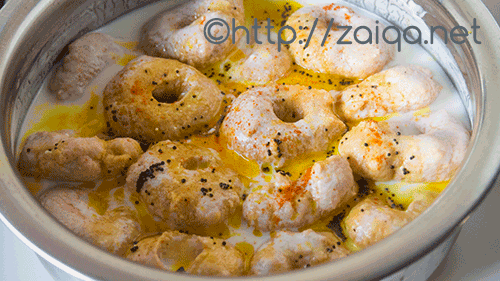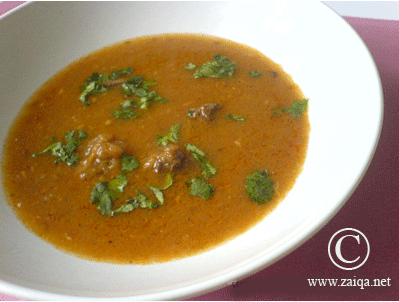Dahi means Yogurt, and Vade, or Vada (vada is a single deep fried lentil ball and vade or vadas is the plural of vada) are the deep fried lentil balls shaped differently according to the recipe in which you are adding them. Different kind of vade are added in different dishes. In this particular recipe the vada are shaped like little doughnuts and added to the Yogurt relish. Dahi-Vade are one of the most favorite snacks enjoyed by Indians. And Muslims in Hyderabad usually prepare it in Ramadhan for Iftaar, when they break the fast.

My version of the Dahi-Vade is simple. I combined the recipes of my Mother and Mother In Law here. Soak the dal a day ahead, then then I go to the kitchen an hour before the Iftaar time to prepare it so that they are just ready before the Iftaar time.
Dahi-Vada – Lentil cakes in Yogurt Sauce
Ingredients:
For the Yogurt Relish-
Yogurt – 500 gms
Water – 1 1/2 cups
Salt – 1/4 tsp
Green Chilli paste – 1 tsp
Sugar – 1/2 tsp
For the Vade-
Urad Dal/Black Gram dal – 1 cup
Green chillies – 2, very finely chopped
Salt – 2 tsp
Water
For the Baghaar
Dry Red Whole Chillies – 2, broken in half, and seeds removed
Mustard seeds – 1/2 tsp
Turmeric powder/Haldi – 1/4 tsp
Canola Oil – 2 tbsp
Cilantro – 1 tbsp, finely chopped
Method:
1. Wash and soak the dal in 2 glasses water overnight.
2. In a large and wide tray, pour in the yogurt, add salt, sugar, water, and green chilli paste. Whisk to mix the yogurt for 5 minutes till the mixture is well blended. Keep in the refrigerator.
3. About 30-40 minutes before you plan to serve the Dahi-Vade, drain the water from the dal and grind them into a smooth and fairly thick batter along the salt and water. Add water drops, as little as possible at a time, just to assist in grinding the dal. The grinded mixture should be fairly thick in consistency as you will be shaping them into vada. Pour the grinded mixture into a bowl. Add the chopped green chillies and mix well.
4. Heat oil to deep fry the vadas in a pan or a kadai. (Never deep fry in a non stick pan)
5. Wet your palm with a few drops of water and spoon about a heaped tablespoon of the mixture onto your wet palm. Wet your index finger and insert it into the centre of the batter to form a hole so that they look like doughnuts. Gently and carefully slip/drop this shaped doughnut into the hot oil and deep fry the vadas in hot oil on both sides until they are nicely golden brown in colour. Remove with a slotted spoon to a plate lined with paper towel. The vadas are ready.
5. Once all the vadas have been fried, drop them in a bowl of warm water. Let them soak for 2 minutes. Gently squeeze excess water from the vadas carefully pressing them lightly between your palms. This is done to soak out the oil. Transfer the soaked and squeezed vade into the earlier prepared cooled yogurt relish. Arrange the vade in the yogurt relish so that each one is nicely dipped into it. Cover the tray and transfer it into the refrigerator. Leave it to soak for 10 minutes.
6. Just before you serve, prepare baghaar. In a small pan, pour the oil and add the ingredients under the heading ‘for baghaar’ except cilantro. Let the spices splutter. Pour this onto the Dahi-Vade all over. Also garnish with cilantro, Serve immediately.
Some Tips:
- For this recipe the lentils are to be soaked before hand, preferably overnight, and grinded. People usually grind the lentils and store the mixture some time ahead of preparing the Dahi-Vade. Here, I suggest NEVER to do so, because I have learnt from my experience, that if you grind it beforehand and keep the mixture at room temperature or in the fridge and you fry the vada out of the mixture later on, they tend to absorb more oil, it becomes thirsty for oil. I have noticed it every time I tried to simplify my work and grind and keep the lentils, when I am free, to deep fry it later on. So I have stopped doing it since and grind it only just before I plan to fry and serve the Dahi-Vade. Or you can grind and deep fry the vadas then and there, ahead of time, and store the fried vadas in the freezer for upto 3 months in an air tight container. When you want to prepare the Dahi-Vade, you simply will have to soak the vadas in warm water for the specified time and then in the yoghurt relish.
- If you end up with many vadas, some people put all the vadas in the yoghurt relish even if they know they will all not be eaten up by your loved ones in home, which results in soggy Dahi-Vadas the next time you feel like having the left over Dahi-Vadas. Instead.. Count the number of people at home whom you are going to prepare and serve this dish, and the number of vade prepared. Do not soak all vade in water and then put them into the yoghurt, instead, store the excess vadas in the freezer. The next time you want to have them, make the yoghurt relish again, and dip the vadas, now in warm water for the specified time, and then in the yoghurt relish. Also NEVER prepare the yoghurt relish before hand too as it turns sour. Always prepare everything fresh for best results and good taste.
Asha of Foodie’s Hope has requested me to send this recipe for RCI Karnataka Cuisine because she says this recipe is very similar to Mosaru vade, which they prepare in Karnataka, So, here’s my recipe Asha, all the way to you!
Luv,
Mona
